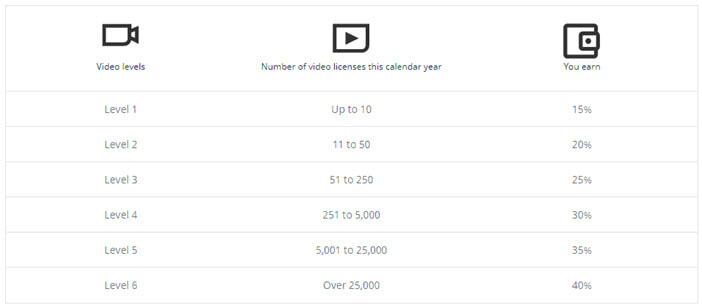Warning: Undefined array key 6 in /home/imgpanda.com/public_html/wp-content/themes/astra/template-parts/single/single-layout.php on line 176
Warning: Trying to access array offset on value of type null in /home/imgpanda.com/public_html/wp-content/themes/astra/template-parts/single/single-layout.php on line 179
Shutterstock is a popular platform for creators to sell their digital content, such as photos, videos, and illustrations. It offers an excellent opportunity for photographers, designers, and videographers to earn passive income by licensing their work to businesses, marketers, and individuals. If you're looking to monetize your creative assets, understanding how Shutterstock's earning system works is key. This guide will help you learn more about how much you can make and what factors influence your Shutterstock earnings.
How Creators Can Make Money on Shutterstock

Shutterstock provides multiple ways for creators to generate income by uploading and selling their content. Here are the most common methods:
- Single Image or Video Sales: You earn a percentage every time a customer purchases a license for one of your images or videos.
- Subscription Downloads: Shutterstock offers subscription plans to buyers. As part of this, you receive royalties when your content is downloaded through these plans.
- Enhanced License Sales: When buyers need extended usage rights, they can purchase an enhanced license, which brings in higher royalties for you.
- Custom Projects: Some creators also receive commissions for custom requests where buyers need specific types of content created.
The more diverse and high-quality content you upload, the better your chances of generating steady income. Be sure to focus on popular and trending subjects to increase your content’s appeal to potential buyers.
Also Read This: Behance views growth strategies
Understanding Shutterstock's Revenue Model

The Shutterstock revenue model operates on a royalty-based system, where contributors earn money based on the number of downloads and the type of license customers purchase. Here’s a breakdown of how it works:
| Type of License | Contributor Earnings |
|---|---|
| Standard License | 15% - 40% per download, based on your contributor level |
| Enhanced License | 20% per download, with higher payouts for larger files |
| Custom or Enterprise Sales | Varies depending on agreement; generally higher than standard rates |
Shutterstock uses a tiered royalty structure where your earnings percentage increases as you hit certain milestones in total lifetime earnings. For example, beginners start at 15% but can eventually earn up to 40% as they reach higher sales levels.
This dynamic incentivizes creators to upload consistently and aim for higher sales volume, as more downloads lead to higher earnings and better royalty percentages.
Also Read This: Cómo Subir Contenido a iStock para Nuevos Contribuidores
Factors That Influence Your Shutterstock Income
Your Shutterstock income is affected by various factors, and understanding them can help you better optimize your earnings. Some of the key factors include:
- Content Quality: High-quality, well-composed images and videos tend to attract more downloads. Poorly lit, overexposed, or overly edited content may not perform well.
- Content Variety: Uploading a diverse range of content, such as images, vectors, and videos in various categories, increases your chances of appealing to a broader audience.
- Keyword Usage: Proper use of relevant keywords helps your content get discovered by buyers. Descriptive and accurate keywords are essential for visibility in search results.
- Trends and Demand: Staying on top of current trends and creating content that aligns with what buyers are looking for will lead to more sales. Research what’s popular in the market and cater to those niches.
- Contributor Level: Shutterstock’s tiered royalty system rewards experienced contributors. The more lifetime earnings you accumulate, the higher your percentage of earnings per download, ranging from 15% to 40%.
By paying attention to these factors, you can improve your visibility on the platform and increase your sales, resulting in higher overall earnings.
Also Read This: How to Showcase Your Multilingual Abilities on LinkedIn
Maximizing Your Earnings Through Shutterstock
To maximize your earnings on Shutterstock, you need to be strategic about both your content and marketing approach. Here are some ways to increase your income:
- Upload Consistently: Regularly uploading fresh content keeps your portfolio active and helps you appear in search results more frequently. Aim for a steady flow of new work each month.
- Focus on High-Demand Categories: Certain types of content, such as business, technology, and lifestyle-related themes, tend to sell better. Research popular categories and focus your efforts on producing content for them.
- Use Effective Keywords: Optimize your metadata with well-researched, relevant keywords. Think like a buyer—what search terms would you use to find your content?
- Monitor Trends: Keep an eye on market trends and seasonal demand. Creating content that aligns with these trends can significantly boost your downloads during peak times.
- Engage in Self-Promotion: Promote your Shutterstock portfolio on social media, blogs, and other platforms to attract more buyers. This increases traffic to your content, leading to more sales.
By following these tips, you can maximize the visibility and appeal of your content, leading to increased downloads and, ultimately, higher earnings.
Also Read This: Creating Your Own COD4 Server A Step-by-Step Gaming Tutorial
Common Challenges Creators Face with Shutterstock
While Shutterstock offers many opportunities for creators, there are also challenges you might face along the way. Here are some of the most common ones:
- High Competition: With millions of contributors uploading content daily, standing out from the crowd can be difficult. To overcome this, focus on niche topics and unique content that sets you apart from others.
- Royalties and Payouts: Shutterstock’s royalty rates may seem low for new contributors, especially since the starting percentage is just 15%. It takes time and significant sales to reach higher royalty levels.
- Content Approval Process: Shutterstock has strict quality standards. It’s not uncommon for submissions to get rejected for reasons like poor lighting or incorrect keywords. Understanding Shutterstock’s guidelines is crucial to reduce rejections.
- Keeping Up with Trends: Trends change quickly, and content that performed well last year might not be relevant today. Creators need to stay flexible and adapt to shifting market demands.
- Time Investment: Building a substantial portfolio and earning significant income on Shutterstock takes time and dedication. Patience is key, especially in the early stages when earnings may be minimal.
Being aware of these challenges will help you manage expectations and navigate the Shutterstock platform more effectively. Persistence and adaptability are crucial to long-term success.
Also Read This: Link Your YouTube Channel to Instagram for Increased Reach
Tracking and Reporting Your Shutterstock Earnings
Keeping track of your Shutterstock earnings is crucial to understanding how well your portfolio is performing and planning your future strategy. Fortunately, Shutterstock provides several tools to help you monitor your earnings in real-time.
Here are some ways to track your Shutterstock earnings:
- Earnings Dashboard: Shutterstock offers an easy-to-use earnings dashboard where you can view your total earnings, number of downloads, and the types of licenses sold. It’s updated regularly, allowing you to see your daily, monthly, and yearly performance at a glance.
- Download Breakdown: You can access detailed reports showing which specific content pieces are being downloaded and how much you earned from each sale. This helps you identify your most popular assets and improve your portfolio accordingly.
- Contributor Level Progress: As you accumulate earnings, you move up through Shutterstock’s royalty tiers. The dashboard shows your progress toward the next tier, helping you stay motivated to increase your sales.
- Export Earnings Reports: For more advanced tracking or tax reporting, you can export your earnings data as a spreadsheet, making it easy to analyze trends or share with an accountant.
By regularly reviewing your earnings data, you can make informed decisions about your content strategy, optimize for higher-performing assets, and track your progress toward larger financial goals.
Also Read This: Understanding LinkedIn Weekly Connection Limits and Strategies to Stay Compliant
Frequently Asked Questions (FAQ)
Here are some common questions creators often have about Shutterstock earnings:
- How much can I earn on Shutterstock? Earnings vary widely based on the quality, quantity, and demand for your content. Some contributors earn a few dollars a month, while others make substantial income through high sales volumes.
- When do I get paid? Shutterstock pays contributors once they reach a minimum threshold of $35. Payments are made monthly, either via PayPal, Skrill, or bank transfer.
- How does Shutterstock calculate royalties? Royalties are based on your contributor level and the type of license buyers purchase. Beginners start at 15%, but experienced contributors can earn up to 40%.
- Can I sell the same content on other platforms? Yes, Shutterstock allows non-exclusive content, meaning you can upload your work to other stock platforms as well, unless you choose to license it exclusively through Shutterstock.
- What content sells best on Shutterstock? Popular categories include business, lifestyle, technology, and seasonal content. However, high-quality and unique images in any category have the potential to perform well.
Conclusion: Final Thoughts on Shutterstock Earnings
Shutterstock offers a flexible way for creators to earn money by selling digital content, but success on the platform requires patience, persistence, and strategic effort. Your earnings will depend on several factors, including the quality and variety of your work, keyword optimization, and your ability to stay in tune with market trends.
While Shutterstock is a competitive marketplace, many creators find it to be a reliable source of passive income once they establish a strong portfolio. Whether you're just starting or looking to grow your existing presence, focusing on consistency, high-demand categories, and proper keywording can significantly boost your income over time.
In the end, the key to success on Shutterstock is to treat it as a long-term investment. With dedication and a clear strategy, you can turn your creative work into a steady income stream.
